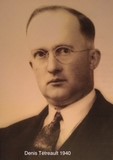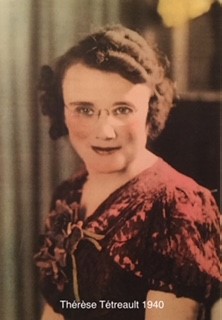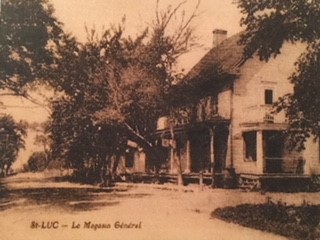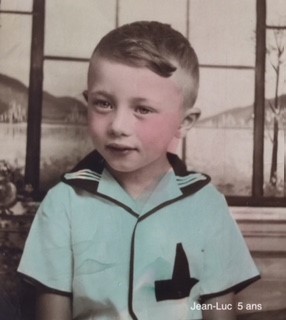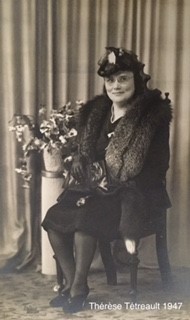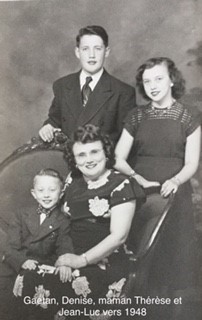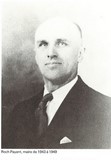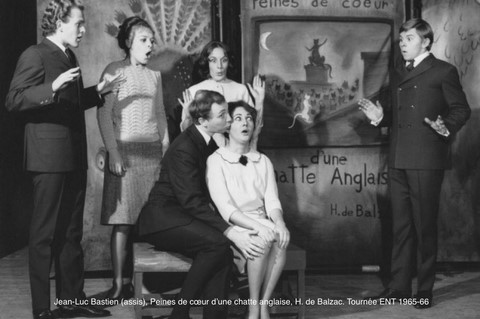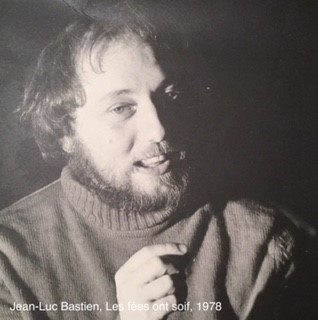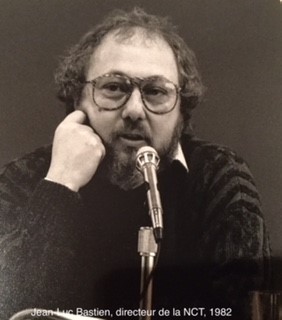Jean-Luc Bastien, born Jean-Luc Tétreault : Son of a merchant and man of the theater (par Marie Josée Bourgeois)
Born in Quebec, Jean-Luc Bastien's career as an actor, a stage director, a theater company director, a teacher, and a theater school director spans four decades. He is a committed practitioner involved in all aspects of advancing creativity in Quebec in regards to theater and professional standards in the practice of theater. He is originally from Saint-Luc, now a part of Saint-Jean-sur-Richelieu in the Montérégie region.
He has lived with lifelong companion Josée Mailhot, an ethnolinguist, from 1968 to 1993, in Montreal, at Saint-Benoît (Mirabel), and at Capileira (Alpujarra) in Spain. He has travelled extensively and visited theatrical establishments outside the country as part of his work. Currently, he roams the world for his own enjoyment and spends time in bridge and scrabble clubs as well as theater and cinema festivals in Montreal. He is fluent in three languages, French, English, and Spanish.
Since 2005, he lends a hand with Projet Changement, an elderly community center at the Grand Plateau Mont-Royal, in various administrative positions, including that of president between 2009 and 2011.
Genealogy
Jean-Luc's ancestor was Joseph-Marie Tétreau dit Ducharme. Denis, his father, changed the spelling to Tétreault. Jean-Luc belongs to the tenth generation of Tétreaults in Quebec.
Saint-Jacques-le-Mineur
Jean-Luc was born on May 12, 1939, the youngest son of Denis Tétreault (1900-1947) and Thérèse Payant dit St-Onge (1903-1997), at Saint-Luc after which he was named since he was the first of their children to be born in that village. The day of his birth coincides with the passing of the royal blue and silver train through Saint-Jean. Aboard were King George VI and his wife Elizabeth on a Canadian tour on the eve of World War II which broke out in August of 1939. This event is remembered in the family legends.
The maternal grandparents, Joseph Payant and Delphine Langevin were farmers in Saint-Jacques-le-Mineur. Three children were born from their union: Roch, Marie-Anne (Derome), and Thérèse. They bequeathed their farm, inherited from the Langevins, to their only son, Roch (1893-1989), and his wife Yvonne.
Life in Saint-Luc-de-Laprairie
Jean-Luc's father, Denis, quit farming to go into business in 1938. At the dawn of World War II, he bought the Saint-Luc general store across from the church. It was an ideal location. He did not fail to capitalize on this opportunity which brought him notoriety and fortune in short order.
Denis transformed the store into a commercial center. In addition to stocking food, kitchenware, and clothing, like in any good general store, his space included the bus station, the post office, the taxi stand, and gas pumps. Next door were a slaughterhouse, a feed store, and stockrooms. In the store, a pool table attracted young and not so young men —which was no problem with the young ladies who would loiter in the store.
This meeting place was the scene where mother Thérèse, had an important role. She handled the haberdashery, placed orders, and dealt with employees. She made weekly runs to Montreal, on Monday morning. The father dealt with the slaughterhouse, purchasing, and general management. As a member of the Association of Retail Merchants of Canada, Denis regularly attended meetings on Monday evenings in Montreal.
The business was open every day from morning till night. It required the hiring of numerous employees with whom Denis established close ties in the manner of a good father. All of the Tétreault children were involved, assuring good service to the customers, especially on Sundays when the store was busiest.
The Country at War, 1939-1945
As it had been a garrison town since the origins of the French colony with the erection of Fort Saint-Jean in 1666, Saint-Jean-sur-Richelieu (formerly Saint-Jean d'Iberville) had a long military tradition which established itself again during World War II with the arrival of the Canadian armed forces in 1941.
The war lasted all the way through Jean-Luc's early childhood. As of the middle of the war, in April, 1942, Canadian families were faced with rationing of sugar, tea, coffee, butter, meat, and gasoline. Rationing coupons were distributed at the store. It was Denise's job to stick the stamps in the booklets. Again related to the war, the family rented a room to a soldier from the Saint-Jean garrison. Since he was the son of store owners in a rural setting who knew how to take advantage of the situation and who numbered farmers among his customers, the young Jean-Luc never really knew any hardship during the war, any more than his sister and brother. Neither Jean-Luc nor his sister Denise remember wanting for anything.
A Course Change
After the war, Thérèse and Denis had precious little time to return to a normal life. Denis died on Saturday, May 31, 1947, struck down by a heart attack while square dancing at the wedding of the sister of one of the store's employees. He had agreed to serve as their chauffeur since, as it was his habit, he had a car of the current year. The newlyweds, Thérèse, his wife, Jean-Luc, his youngest son, and the wedding guests all looked on helplessly as the six-foot giant crumbled to the ground while doing what he loved — feasting and dancing — an aptitude that the youngest son would inherit.
The reception which turned into a tragedy was held at the home of the bride's parents, in the last house on Saint-Gabriel Road, quite far from the village. It took time to reach a doctor. It also took a while for the hearse to arrive. It came from Farnham where a Mailloux cousin was funeral director. While waiting, the relatives of the newlyweds took care of the widow and the children, and the guests surrounded the body in a respectful presence until nightfall. Jean-Luc had just turned 8 years old.
Two weeks earlier, for his confirmation, his father had trained him in the art of writing and delivering a speech for the occasion. This became an indelible memory. The funeral took place after three long days at the parish hall receiving condolences — endless for a child. Before leaving for church, as a family, they all cried with abandon. Once there, Jean-Luc behaved like an adult, and he went to inscribe his signature, with authority for a second grader, in the register, next to that of his big brother, of his uncles, and of the priest, his father's cousin. There were many religious in the family. In fact, it wouldn't have taken much for him to be sent to the seminary. There were several letters to that effect slipped into the coffin. Fortunately, his mother did not agree and much preferred to keep him close.
Now left without his father that he loved so much, Jean-Luc felt isolated. His sister Denise was beginning to go out with boys and his brother Gaetan replaced his father at the store. In June of that year, the Cinéma Cartier from Saint-Jean presented Les deux orphelines, with Alida Valli, a major successful movie that made the rounds of Quebec Province; soprano Claire Gagnier, nicknamed the Canadian Nightingale, was on tour at the Centrale catholique of Saint-Jean; and Gratien Gélinas, a playwright and actor, invited by the Knights of Columbus, spoke on the future of the theater in French Canada. They kept this connection, often meeting at a restaurant, while traveling, or at family gatherings.
For Jean-Luc, this marked the end of happy times spent playing in the store and observing his father dealing with the comings and goings of customers and of suppliers, intermixed with juicy stories and gossip about the village that seemed to come straight out of a universe that would later be captured in the movie Mon oncle Antoine by Claude Jutra.
Vacations
During school vacations and into adolescence, Jean-Luc would spend a few weeks every summer at his uncle's on his mother's side, Roch Payant, the mayor of Saint-Jacques-le-Mineur from 1943 to 1949. Roch and his wife were childless, so they eagerly awaited the summer visit of the young Tétreaults. The latter took turns going and enjoyed their Tétreault cousins as well as helping out with farm work. This was also an opportunity to see the Tétreau grandparents who lived nearby.
With their mother Thérèse, however, they lived large. Sundays were spent touring by car with their driver, Maurice, who sat alone in the front seat. Denise, mother Thérèse, and Gaetan sat in the back, and Jean-Luc in the folding seat. This was an opportunity to get around, to visit family, and to discover famous places like the Château Frontenac, Sainte-Anne-de-Beaupré, Ausable Chasm in the State of New-York, Missisquoi Bay, and many other places.
Jean-Luc finished elementary school in the village and continued on to spend a year at the Catholic High School of Montreal on Durocher Street to learn English, following his mother's wishes. He traveled there by bus, at first accompanied by his sister Denise who worked for an insurance company in Montreal. After all, he was only 13. The following year, he continued his secondary education with a private tutor at the Saint-Jean Institute directed by Lucien Boyer, then to Montreal at the Boyer Institute, always with professor Boyer, the "poet-professor" as later described by novelist Claude Jasmin, a classmate of Jean-Luc's. And, as always, the bus picked him up at the door.
Professional training
As early as 1956, Jean-Luc regularly went to the Théâtre du Nouveau Monde (TNM) playing at the Gesù. He was intrigued by the billboards until, one December evening, he went to the Théâtre Saint-Denis to see the play Lorenzaccio by a troupe from the Théâtre national populaire in which Gérard Philippe had the lead role. He was fascinated by the famous French stage actor. It was a revelation! This was a path he wanted to take. So he went into a formation program for the theater that lasted seven years. He took courses in bodily expression with Suzanne Rivest (1957-1959). He followed up with courses in drama with Jean Doat (1958-1960), and in modern dance with Françoise Riopelle (1959-1960).
After having rented a room in Saint-Louis Square, he moved to Montreal permanently in 1958, to an apartment owned by his mother on De Lorimier Avenue at first, and then on Sherbrooke Street. Given his skill with typing and with the English language, he easily found employment at Office Overload and at Eaton to correct the French on the restaurant menus. The earnings took care of little treats since his school expenses and cultural experiences were covered by his mother.
That same year, the general store was sold. His mother nevertheless kept the post office which she ran from her apartment in Saint-Luc for several years. In a short time, Thérèse, who was postmistress and landowner, abandoned the idea of being in business. She wasn't as adept at it as her husband had been. But soon, she felt the need to keep busy and to earn a living.
Being proud and resourceful, she found work in catering, first with the restaurant Chez Pierre, and then at the Tour Eiffel on Stanley Street, a high end restaurant serving fish and seafood. The menu had been designed by Frédéric Back (1924-2013). In that setting, an Italian decor created by a team that included Back, Thérèse's jovial personality and abounding energy made her much appreciated. She worked there six evenings a week until her death at age 74, in August of 1977. Genetics doesn't lie. Jean-Luc, the theater producer well known for his gastronomic soirées, followed in her footsteps. Like mother, like son !
Using his savings, Jean-Luc indulged himself with a trip to New York with his friends (1959). This was his first trip out of the country, but would not be his last. He returned the following year to think about his future. This time, the trip was a gift from his mother. Then he spent three years at the National Theater School where he was the first to graduate in theatrical performance. As was common at the time, he took a stage name, Bastien, after a character he had played. Without knowing it, he had taken the name of Madeleine Vanasse Bastien, the daughter of Sébastien Jean-Baptiste Vanasse dit Bastien, the widow of Antoine Végiard Labonté and the second wife of his ancestor Joseph-Marie Tétreau dit Ducharme.
Europe, 1963
The craft had its demands, hastening Jean-Luc's departure from the bosom of the family. There followed two periods at Stratford in Ontario, a first appearance on a professional stage at the Théâtre-Club in a production by Gabriel Gascon, and then, in July 1963, a first trip to Europe on the SS Homeric for a year of study in France, encouraged by actor and director, Jean Gascon. He continued his formation in acting and in diction in Paris (1963-1964) along with Tania Balachova, René Simon, Françoise Rosay and Raymond Rouleau. Following this, he spent a period of time with the State Troupes in France — among others at the Théâtre national populaire directed by Georges Wilson as well as with Roger Planchon. Once these engagements were completed, and after a short stint in Portugal, he returned home on the wings of Canadian Pacific Airlines.
Armed with so much background, it's easy to imagine that Jean-Luc would become a man of action, an organizer, at times an instigator, in the theater as we know it.
Professional Life1
Upon returning to Quebec, Jean-Luc undertook a province-wide tour with young stage actors from the National Theater School, followed by a Canadian tour from coast-to-coast that would last from September, 1965, to July, 1966, intersperced by a few trips back to Montreal. Next, he practiced his trade as a stage actor and occasionally on television where he played various minor roles. Notably, he acted out the part of the young Genaple in D'Iberville, produced by Roland Guay and Pierre Gauvreau, and that of the African king in La Ribouldingue by Marcel Sabourin, both broadcasted on Radio-Canada at the end of the 1960s.
He worked mainly on stage in plays by Molière, Marivaux, Feydeau, Camus, Lorca, Cocteau, Ghelderode, Beaumarchais, and Shakespeare, under the direction of Georges Groulx, Gabriel Gascon, Jean-Pierre Ronfard, Paul Buissonneau, and Pierre Dagenais.
He wasn't yet thirty years old when he was named assistant entertainment director at Man and his World (1968). In that era of the emergence of a national dramatic arts scene and of taking a new look at the whole theatrical institution, he was involved with Louisette Dussault, Odette Gagnon, Jean-Claude Germain, Nicole Leblanc, Gilles Renaud, and Monique Rioux in the founding of the Théâtre du Même Nom (TMN).
Involvement in the Theater of Quebec
Teaching
Jean-Luc Bastien's most enduring involvement and probably his most important legacy remains the diffusion of knowledge. In the field, he accomplished the important work of promotion in various regions (with the Association du jeune théâtre du Québec (AQJT), followed with the Association québécoise du jeune théâtre, then the Théâtre populaire d’Alma, the Festival du théâtre étudiant du Québec of Lac‐Mégantic and finally with the Théâtre populaire du Québec). His pedagogical accomplishments are most significant at Lionel-Groulx College where he taught for 31 years at the Option Théâtre having been recruited by its founder, Jean-Robert Rémillard in 1969. As an aside, Jean-Robert Rémillard, a man of the theater, of letters, and of agriculture, was the son of farmers from Saint-Jacques-le-Mineur, and their respective families knew each other well. They came to realize this much later.
At Lionel-Groulx, Jean-Luc led the Interpretation Section (1971-1972), and then the Theater Department (1972-1995) where he placed priority on original works by Quebec authors. He retired from teaching in 2000.
Under his directorship, hundreds of students of acting and of directing were trained and started a career. Enjoying a rather marginal status at its founding, the Option Théâtre grew in importance in the course of the years. When Jean-Luc left it in 1995, it had become the most active division of the school with musical theater being added in 2002. Today, Lionel-Groulx College, a public institution as of 1976, offers a range of pre-university and technical programs, including about ten in stage and visual arts.
Notes
1 Much of the information on Jean-Luc Bastien's professional career is taken from a biographical notice drawn up in 2016 by Pierre MacDuff to whom I owe a debt of gratitude.
2 Jean-Luc Bastien et Pierre MacDuff (1988). La Nouvelle Compagnie théâtrale : En scène depuis 25 ans, Montréal, VLB, 315 p.
Sources
• Jean-Luc Bastien, archives personnelles, 1939 à 2012
• Denise Tétreault-Prairie, Ma vie, édition personnelle, droits réservés, mai 2004, 148 p.
WEB Sites
• https://fr.m.wikipedia.org/wiki/Jean-Luc_Bastien created by Pierre MacDuff, February 7, 2017
• http://www.ville.saint-jean-sur-richelieu.qc.ca/portrait/Pages/ville-militaire-garnison.aspx retrieved May 10, 2017
• http://www.encyclopediecanadienne.ca/fr/article/les-enfants-canadiens-pendant-la-deuxieme-guerre-mondiale-1/ retrieved May 20, 2017
• http://bilan.usherbrooke.ca/bilan/pages/evenements/20876.html retrieved May 20, 2017
• http://www.clg.qc.ca/le-college/ retrieved May 20, 2017
• http://www.fredericback.com/illustrateur/architecture-interieure/media_restaurants_P_1013.fr.shtml retrieved May 20, 2017
• http://vieux-saint-jean.com/patrimoine/lancienne-ville-de-saint-jean-sur-richelieu/retrieved November 25, 2017
• http://www.famille-arbour.com/2012/02/02/histoire-famille-tetreau-louis-1663/retrieved November 25, 2017
• http://www.claude.dupras.com/les_ducharme.htm retrieved November 25, 2017
• http://tetreaultgenealogie.com retrieved October 2016
Photos
• Jean-Luc Bastien and family, family archives
• Roch Payant, archives of the Municipality of Saint-Jacques-le-Mineur, from Lise Sauriol, mayor, 2017
Aknowledgements
• Paul Lafrance, revision, Gatineau
• Pierre MacDuff, assistance at writing and research, Montreal
• Denise Tétreault-Prairie, assistance at research, Montreal


